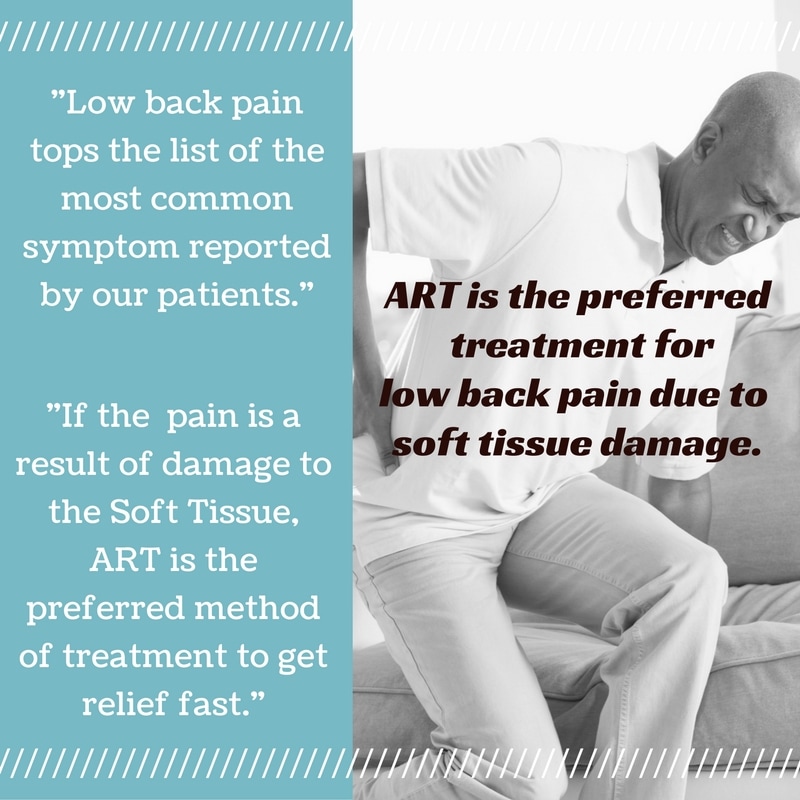Low back pain tops the list of the most common symptom reported by our patients. There are many reasons why people experience low back pain, but tight dysfunctional muscles that are tugging and pulling at the attachment sites around the joints or irritating nerves are often what are causing the injury.
Many people just put up with low-back pain but many people don’t realize that this can often be avoided with ART. Lower back pain can present itself in many different ways. The pain can feel achy, sharp, dull, shooting down to the knee, or even worse, pain shooting down to the feet and toes.
A number of factors can contribute to back pain:
- Exerting too much force on your back such as by lifting or moving heavy objects.
- Repeating certain movements, especially those that involve twisting or rotating your spine, can injure your back.
- An inactive job or a desk job can contribute to back pain, especially if you have poor posture or sit all day in a chair with inadequate back support.
How ART Soft Tissue Therapy can help:
Active Release Techniques is a Soft Tissue Technique the quickly and effectively allows a provider to diagnose and treat the Soft Tissues of the body such as muscles, tendons, ligament, fascia, and even nerves. Now if a person is suffering from structural damage such as a broken bone or a disc herniation, Active Release Techniques will not be the tool that the patient needs to get relief. If a person is experiencing pain as a result of damage to the Soft Tissue, ART is the preferred method of treatment to get relief fast.
When a person presents with low back pain we most often we begin by addressing the psoas (pronounced SO-as) muscles. The psoas muscles are the primary connectors between your torso at the bones and discs in your low back and your legs. They affect your posture and help to stabilize your spine.
The psoas muscles are made of both slow and fast twitching muscles. Because they are major flexors, weak psoas muscles can become tight and pull on their attachment sites in the bones and discs in the low back causing pain. This can also cause many of the surrounding muscles to compensate and become overused. Tight or overstretched psoas muscles are commonly the cause of low back and pelvic pain. When we get the psoas to “release” with Active Release Techniques, the pain often disappears.
Things you can do at home:
- Pay attention to posture. When standing, balance your weight evenly on your feet. Don’t slouch. To promote good posture when sitting, choose a chair that supports your spinal curves. Adjust the height of your chair so that your feet rest flat on the floor or on a footrest and your thighs are parallel to the floor.
- Lift properly. When lifting and carrying a heavy object, lift with your legs and tighten your core muscles. Hold the object close to your body. Maintain the natural curve of your back. Don’t twist when lifting.
- Modify repetitive tasks. Try to alternate physically demanding tasks with less demanding ones. If you work at a computer, make sure that your monitor, keyboard, mouse and chair are positioned properly. If you frequently talk on the phone and type or write at the same time, place your phone on speaker or use a headset. Avoid unnecessary bending, twisting and reaching. Limit the time you spend carrying heavy briefcases, purses and bags. Consider using a rolling suitcase.
- Listen to your body. If you must sit for a prolonged period, change your position often. Periodically walk around and gently stretch your muscles to relieve tension.
- Perform Daily Self-Massage/Stretches. Performing simple self-massage and stretching techniques to loosen up muscles that directly attach to the spine helps to alleviate tension and pain in the low back.

